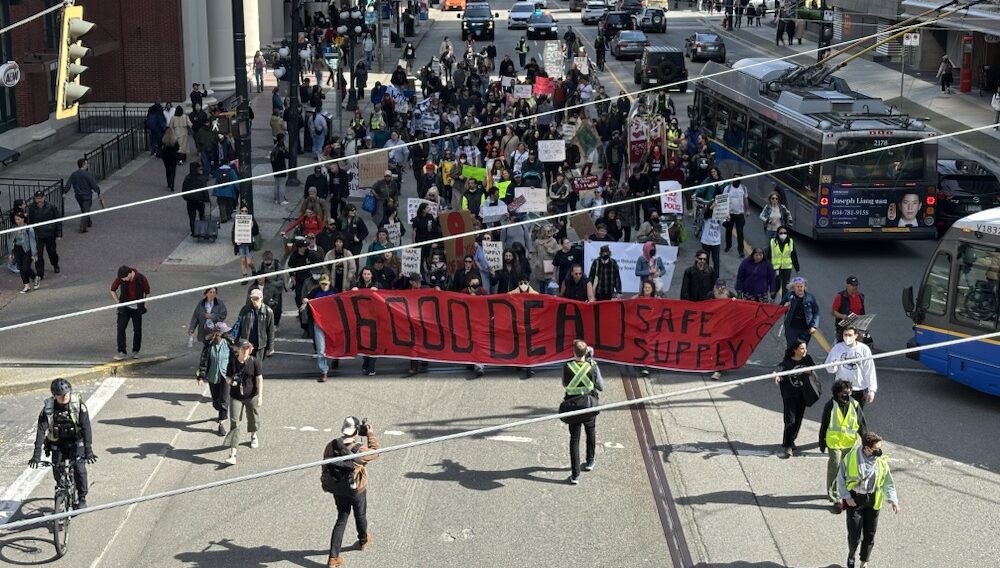As overdose deaths continue to pile up in British Columbia, hundreds of people demonstrated in Vancouver last month to demand solutions to the crisis. A week later, turning a deaf ear, the municipal administration changed the zoning of the worst-affected neighbourhood… in favour of unaffordable condo towers.
In mid-April, workers, community organizations, bereaved families and indigenous activists came together to denounce the authorities' management of the crisis that has claimed the lives of over 16,000 people since 2016. That year, the province's government declared a “public health emergency” which has only increased repression against the province's poorest without improving the situation, according to the protesters.
At the end of April, Mayor Ken Sim and his ABC party modified the Downtown Eastside urban plan. The weak requirements for non-market housing were removed, and 32-storey towers are now permitted. For many, despite the neighbourhood's problems with poverty and drug consumption, this is above all a way of driving out poor and native populations to make way for developers, without addressing the root of the problem.
At the April 14 march, demonstrators denounced this vision of the city's development. Scotty, an organizer with the Vancouver Area Network of Drug Users, suggested that some were looking to capitalize on the drug crisis and poverty: “Law enforcement… the ABC party… They want to make an executive city out of Vancouver and push all the poor people out.”
The “executive city,” according to Scotty, represents a Vancouver tailor-made for business—a city where luxury development takes precedence, even if it means displacing poor residents. This vision relies on aggressive urban policies that include less public housing, fewer social services and more high-end buildings. The aim: to attract capital, tourists and the wealthy classes, even if it means sacrificing the most vulnerable.

For his part, Byron Wood, of the organization Workers for Ethical Substance Use Policy, pointed out a reality too often disregarded: “Workers and people who use drugs are the same people.” He drew on government data showing that between 33% and 50% of overdose victims were employed at the time of their death.
The phenomenon particularly affects industries where work-related accidents are frequent, such as construction. Many develop an addiction to opioids prescribed for pain relief, with sometimes fatal consequences. Wood adds that this statistic excludes pensioners, volunteers, apprentices, the unemployed and workers sidelined because of their state of health or employer sanctions.
A repressive “public health crisis”
The demonstrators took aim at the provincial government's response to the crisis. They denounced the fact that, rather than attacking the heads of the criminal networks that profit from trafficking while expanding access to help for people addicted to opioids, British Columbia has fallen back on the old recipes of the “war on drugs,” without consideration for the root causes of the problem.
“I think the real cause is capitalism,” explains J. Shantz, a faculty member in the Department of Criminology at Kwantlen Polytechnic University, in an interview with The North Star at the rally. “It's a system […] which puts people in conditions of utter despair and misery and without the supports that are needed to get through life.”
“Workers who are put into horrible, unsafe and unhealthy working conditions, end up using—as we all do in our own ways—various substances to get through a shitty working day,” he continued.
“It's important to stress that a lot of the worst crises, in terms of police violence, in terms of homelessness, in terms of toxic drug crisis, are happening really intensively in suburban areas… and what's really overlooked is the way in which resources aren't available in the suburbs.”
Shantz concludes, “[The government] don't want any public resources going towards housing, towards healthcare, social welfare, to anything that is going to support a population that they view as expendable.”
In closing, Scotty adds that the municipal and provincial governments want Vancouver, “like Rio de Janeiro, to have slums on the outside of this festering city.”


